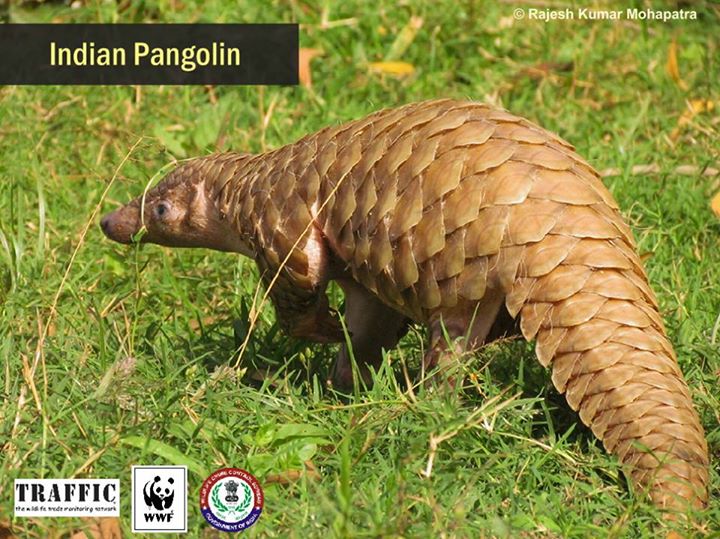compiled by Dr. Susan Sharma
The pangolin is a slow, shy animal. The word "pangolin" itself has a French origin and refers to the animal's ability to curl up into a ball.
Distribution

The pangolin contains one genus and seven species. Among them Indian pangolin (Manis carssicaudata) inhabits the foothills and plains of India and SriLanka. A Chinese pangolin (M. pentadactyla) ranges westward through Nepal, Assam and eastern Himalaya, Myanmar,
and China. The Malayan pangolin (M. javania) occurs in Malaya, Java, and Indochina. The Chines pangolin has been reported from different areas of Nepal.
Characteristics
The pangolin measures 58 cm head and body and 45 cm tail. It has 18 rows of overlapping scales around the body. Females as a rule are smaller than males. The pangolin possesses hair and scales, an unusual combination for mammals. It has a small pointed head
and narrow mouth with a fine set muzzle. It also has a fleshy nose bearing nostrils. The eyes and ears are small and the head integrates smoothly into a short neck and later merges directly into the roundish body. The short legs come down the body and are
tipped with sharp claws. The forefeet are longer and stronger than the hind feet. The pangolin is a burrowing nocturnal mammal. Mostly pangolins burrow into the ground by means of their heavily clawed fore-foot and make a chamber about eight feet deep. They
do so within three to five minutes. After the burrow is made, the entrance is blocked. They are also known to occupy the burrows of other animals.
Generally a single young is born measuring 18 inches (45 cm) and weighing about 1 lb. At the time of birth, scales are soft and flexible but they harden in two days. The young pangolin is able to walk soon after birth. The young are carried on the mother's
tail or back where they hang limply on the root. A threatened mother folds her tail and keeps her young under her body. Male pangolins also exhibit a remarkable parental instinct and share a burrow with females and young ones.
They are nocturnal, coming out during the night for feeding on eggs and adult termites and ants. It is reported from Kannyakumari district in Tamil Nadu
that they also feed on the soft shelled land mollusks found in gardens and cultivated lands. It is not known how they feed on mollusks - they possibly break the shells with their strong nails as evident in the crumbled shells in their hide outs.
Pangolins Under Threat
Known by various names such as Bajrakit (Sanskrit), Banrui (Bengal), Sallu Samp (Hindi) and Enampeechi (Malayalam), habitat loss and hunting for meat and
scales are the major threats to the species. Pangolin's meat is eaten as great delicacy by hill tribes and their scales are made into a ring as a charm against rheumatic fever. And some hill tribes believe that its flesh has aphrodisiac values. As a result
of these values, pangolins are easily hunted and trapped.
Pangolin scales are extracted after killing and skinning the animal. Scales from one adult animal weigh an average of 1kg. Oil is extracted from the fat
of the animal (amounting to 250 grammes per animal) for medicinal purposes. The brain of the animal is used by local medicine men.
Trade
The trade pattern is such that it mostly goes undetected and therefore unrecorded. The reported international trade in its products generally involves two commodities - scales and skin. It is recorded that about 700 skins of Indian Pangolin were exported to
the USA in 1983 compared to 5,023 skins between 1980-1982. The price of one pangolin in the USA was about $US6 and 1kg of scales is valued $US18. The prices of scales vary from INR 250-500 per kg at the collection points; INR 500 - 1000 per kg at the main
trading centers; and INR 900 - 1500 per kg at the border trading centres. The international market prices are reported to be INR 7000 - 8000 per kg. The traders in all the states are mainly the tribal charmers. Generally they are the direct primary level sellers,
though there is sometimes involvement of middlemen or agents. The tribal communities in the rural areas are directly involved in hunting while the middlemen or the agents usually buy the products from them. However, some agents were found to be hunters themselves.(
TRAFFIC Report)
A recent study by Indian Society for Wildlife Research pointed out that Bhubaneswar and Cuttack in Orissa are two main corridors of illegal trading of pangolins.
On an average about 22 shops in Badambadi area ( Bhubaneswar) trade in flesh and rings from scales. Hawkers for these are even found in West Bengal.
Status
The IUCN Red List of Threatened Animals (1996 ) lists as internationally threatened or near-threatened . one species of pangolin (Manidae). At the 11th meeting of the Conference of the Parties to CITES in April 2000, a proposal to transfer Asian Pangolins Manis
crassicaudata, M. pentadactyla and M. javanica from Appendix II to Appendix I was put forward by India, Nepal, Sri Lanka and the USA. This proposal was rejected despite the fact that the Parties acknowledged that Asian Pangolin populations are increasingly
under threat due to domestic and international demand as well as habitat destruction.